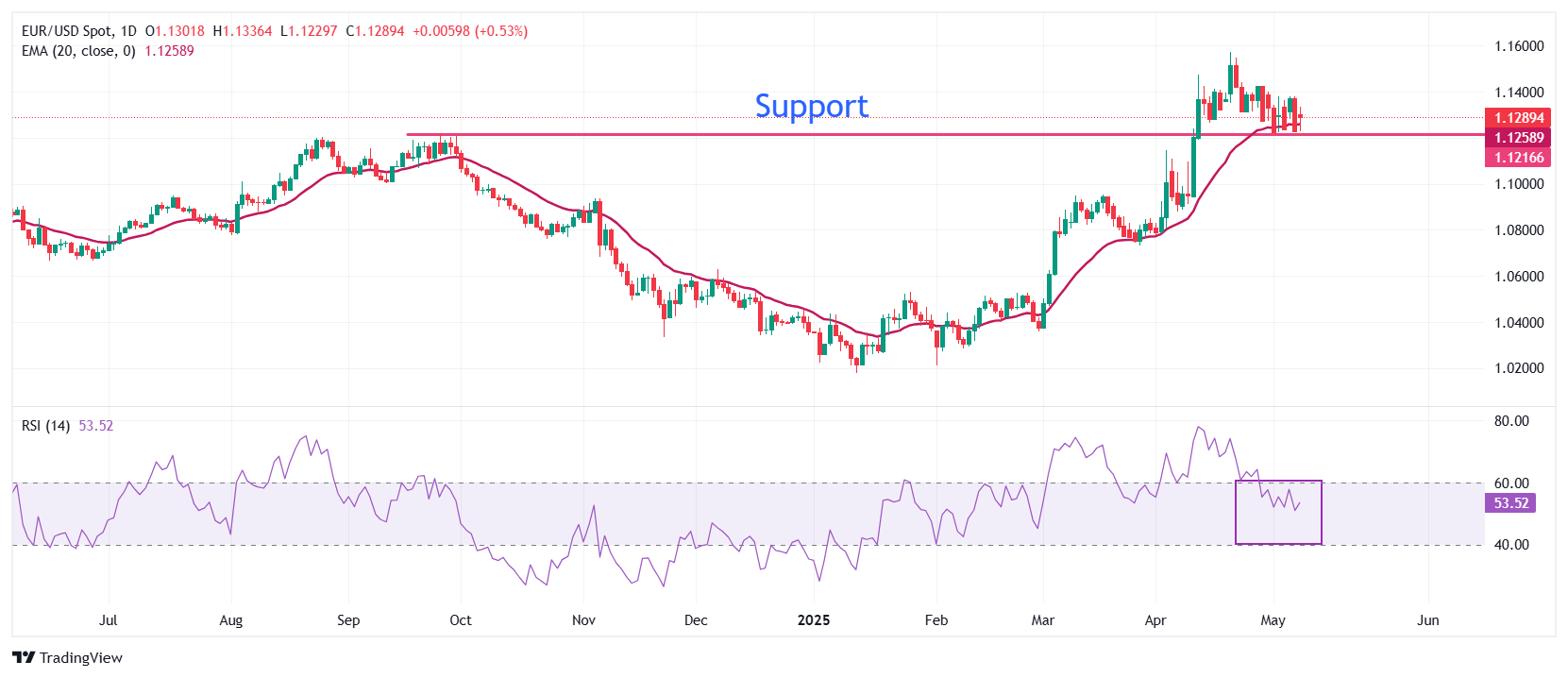Created
: 2025.05.08














![]() 2025.05.08 18:54
2025.05.08 18:54
EUR/USD ticks lower below 1.1300 during European trading hours on Thursday. The major currency pair edges down as the US Dollar (USD) trades slightly higher on signals from the Federal Reserve (Fed) that there is no rush to lower interest rates, which came on Wednesday just after the central bank left interest rates unchanged in the range of 4.25%-4.50% for the third time in a row.
The US Dollar Index (DXY), which gauges the Greenback's value against six major currencies, ticks higher to near 100.00.
Fed Chair Jerome Powell stated that "uncertainty about the economic outlook has increased further" due to the fallout of tariffs announced by United States (US) President Donald Trump, which have skewed "risks to both inflation and unemployment on the upside". Therefore, Powell advised that the right thing for the Fed now is to "await more clarity".
According to the CME FedWatch tool, traders are confident that the Fed will also keep borrowing rates steady in the June policy meeting, but see around a 66% chance of interest rates being lower than current levels in July.
Meanwhile, investors await the announcement of the first bilateral trade deal by the White House under the leadership of US President Trump. On Wednesday, Trump declared through a post on Truth.Social that his team has closed a deal with one of his trading allies, which will be public on Thursday at 14:00 GMT. According to a report from The New York Times (NYT), the trading partner will be the United Kingdom (UK). This contradicts what Trump signaled last week on the NewsNation television network that India, South Korea, and Japan would be the first countries to close trade deals.
However, financial market participants are mainly focusing on trade discussions between the US and China, which are scheduled for Saturday in Switzerland. US Treasury Secretary Scott Bessent and Trade Representative Jamieson Greer confirmed that they will meet their Chinese counterparts, aiming to de-escalate the trade war.

EUR/USD ticks lower below 1.1300 on Thursday. The pair continues to hold the 20-day Exponential Moving Average (EMA) around 1.1260.
The 14-day Relative Strength Index (RSI) falls inside the 40.00-60.00 range, indicating that the bullish momentum is concluded for now. However, the upside bias still prevails.
Looking up, the psychological level of 1.1500 will be the major resistance for the pair. Conversely, the September 25 high of 1.1214 will be a key support for the Euro bulls.
The Euro is the currency for the 19 European Union countries that belong to the Eurozone. It is the second most heavily traded currency in the world behind the US Dollar. In 2022, it accounted for 31% of all foreign exchange transactions, with an average daily turnover of over $2.2 trillion a day. EUR/USD is the most heavily traded currency pair in the world, accounting for an estimated 30% off all transactions, followed by EUR/JPY (4%), EUR/GBP (3%) and EUR/AUD (2%).
The European Central Bank (ECB) in Frankfurt, Germany, is the reserve bank for the Eurozone. The ECB sets interest rates and manages monetary policy. The ECB's primary mandate is to maintain price stability, which means either controlling inflation or stimulating growth. Its primary tool is the raising or lowering of interest rates. Relatively high interest rates - or the expectation of higher rates - will usually benefit the Euro and vice versa. The ECB Governing Council makes monetary policy decisions at meetings held eight times a year. Decisions are made by heads of the Eurozone national banks and six permanent members, including the President of the ECB, Christine Lagarde.
Eurozone inflation data, measured by the Harmonized Index of Consumer Prices (HICP), is an important econometric for the Euro. If inflation rises more than expected, especially if above the ECB's 2% target, it obliges the ECB to raise interest rates to bring it back under control. Relatively high interest rates compared to its counterparts will usually benefit the Euro, as it makes the region more attractive as a place for global investors to park their money.
Data releases gauge the health of the economy and can impact on the Euro. Indicators such as GDP, Manufacturing and Services PMIs, employment, and consumer sentiment surveys can all influence the direction of the single currency. A strong economy is good for the Euro. Not only does it attract more foreign investment but it may encourage the ECB to put up interest rates, which will directly strengthen the Euro. Otherwise, if economic data is weak, the Euro is likely to fall. Economic data for the four largest economies in the euro area (Germany, France, Italy and Spain) are especially significant, as they account for 75% of the Eurozone's economy.
Another significant data release for the Euro is the Trade Balance. This indicator measures the difference between what a country earns from its exports and what it spends on imports over a given period. If a country produces highly sought after exports then its currency will gain in value purely from the extra demand created from foreign buyers seeking to purchase these goods. Therefore, a positive net Trade Balance strengthens a currency and vice versa for a negative balance.
This contradicts what Trump signaled last week on the NewsNation television network that India, South Korea, and Japan would be the first countries to close trade deals.
![]()
Created
: 2025.05.08
![]()
Last updated
: 2025.05.08

FXStreet is a forex information website, delivering market analysis and news articles 24/7.
It features a number of articles contributed by well-known analysts, in addition to the ones by its editorial team.
Founded in 2000 by Francesc Riverola, a Spanish economist, it has grown to become a world-renowned information website.
We hope you find this article useful. Any comments or suggestions will be greatly appreciated.
We are also looking for writers with extensive experience in forex and crypto to join us.
please contact us at [email protected].
Disclaimer:
All information and content provided on this website is provided for informational purposes only and is not intended to solicit any investment. Although all efforts are made in order to ensure that the information is correct, no guarantee is provided for the accuracy of any content on this website. Any decision made shall be the responsibility of the investor and Myforex does not take any responsibility whatsoever regarding the use of any information provided herein.
The content provided on this website belongs to Myforex and, where stated, the relevant licensors. All rights are reserved by Myforex and the relevant licensors, and no content of this website, whether in full or in part, shall be copied or displayed elsewhere without the explicit written permission of the relevant copyright holder. If you wish to use any part of the content provided on this website, please ensure that you contact Myforex.
Myforex uses cookies to improve the convenience and functionality of this website. This website may include cookies not only by us but also by third parties (advertisers, log analysts, etc.) for the purpose of tracking the activities of users. Cookie policy